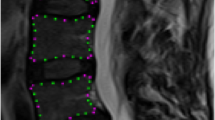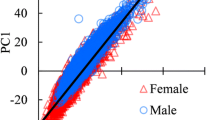Abstract
Purpose
We have previously shown that the lumbar spine has an intrinsic shape specific to the individual and characteristic of sitting, standing and supine postures. The purpose of this study was to test the hypothesis that this intrinsic shape is detectable throughout a range of postures from extension to full flexion in healthy adults.
Methods
Sagittal images of the lumbar spine were taken using a positional MRI with participants (n = 30) adopting six postures: seated extension, neutral standing, standing with 30, 45 and 60° and full flexion. Active shape modelling (ASM) was used to identify and quantify ‘modes’ of variation in the shape of the lumbar spine.
Results
ASM showed that 89.5 % of the variation in the shape of the spine could be explained by the first two modes; describing the overall curvature and the distribution of curvature of the spine. Mode scores were significantly correlated between all six postures (modes 1–9, r = 0.4–0.97, P < 0.05), showing that an element of intrinsic shape was maintained when changing postures. The spine was most even in seated extension (P < 0.001) and most uneven between 35 and 45° flexion (P < 0.05).
Conclusions
This study shows that an individual’s intrinsic lumbar spine shape is quantifiable and detectable throughout lumbar flexion and extension. These findings will enable the role of lumbar curvature in injury and low back pain to be assessed in the clinic and in the working and recreational environments.




Similar content being viewed by others
References
Meakin JR, Gregory JS, Smith FW, Gilbert FJ, Aspden RM (2008) Characterizing the shape of the lumbar spine using an active shape model: reliability and precision of the method. Spine 33(7):807–813
Ali AH, Cowan AB, Gregory JS, Aspden RM, Meakin JR (2012) The accuracy of active shape modelling and end-plate measurements for characterising the shape of the lumbar spine in the sagittal plane. Comput Method Biomech 15(2):167–172
Meakin JR, Gregory JS, Aspden RM, Smith FW, Gilbert FJ (2009) The intrinsic shape of the human lumbar spine in the supine, standing and sitting postures: characterization using an active shape model. J Anat 215(2):206–211
Roberts MG, Oh T, Pacheco EM, Mohankumar R, Cootes TF, Adams JE (2012) Semi-automatic determination of detailed vertebral shape from lumbar radiographs using active appearance models. Osteoporos Int 23(2):655–664
Roberts M, Cootes TF, Adams JE (2006) Vertebral morphometry—semiautomatic determination of detailed shape from dual-energy X-ray absorptiometry images using active appearance models. Invest Radiol 41(12):849–859
Meakin JR, Aspden RM, Smith FW, Gilbert FJ (2007) The effect of load on the shape of the lumbar spine. J Biomech 40:270
Meakin JR, Smith FW, Gilbert FJ, Aspden RM (2008) The effect of axial load on the sagittal plane curvature of the upright human spine in vivo. J Biomech 41(13):2850–2854
Aspden RM (1989) The spine as an arch. Spine 14(3):266–274
El-Rich M, Shirazi-Adl A, Arjmand N (2004) Muscle activity, internal loads, and stability of the human spine in standing postures: combined model and in vivo studies. Spine 29(23):2633–2642
Cholewicki J, McGill SM (1996) Mechanical stability of the in vivo lumbar spine: implications for injury and chronic low back pain. Clin Biomech 11(1):1–15
Hodges PW, Richardson CA (1996) Inefficient muscular stabilization of the lumbar spine associated with low back pain: a motor control evaluation of transversus abdominis. Spine 21(22):2640–2650
Aspden RM (1988) A new mathematical model of the spine and its relationship to spinal loading in the workplace. Appl Ergonom 19(4):319–323
Patwardhan AG, Havey RM, Meade KP, Lee B, Dunlap B (1999) A follower load increases the load-carrying capacity of the lumbar spine in compression. Spine 24(10):1003–1009
Meakin JR, Aspden RM (2012) Modelling the effect of variation in sagittal curvature on the force required to produce a follower load in the lumbar spine. J Mech Med Biol 12(1):1250013-1–1250013-10
Arjmand N, Plamondon A, Shirazi-Adl A, Larivière C, Parnianpour M (2011) Predictive equations to estimate spinal loads in symmetric lifting tasks. J Biomech 44(1):84–91
Han KS, Rohlmann A, Yang SJ, Kim BS, Lim TH (2011) Spinal muscles can create compressive follower loads in the lumbar spine in a neutral standing posture. Med Eng Phys 33(4):472–478
Shirazi-Adl A (2006) Analysis of large compression loads on lumbar spine in flexion and in torsion using a novel wrapping element. J Biomech 39(2):267–275
Shirazi-Adl A, Parnianpour M (2000) Load-bearing and stress analysis of the human spine under a novel wrapping compression loading. Clin Biomech 15(10):718–725
Shirazi-Adl A, El-Rich M, Pop DG, Parnianpour M (2005) Spinal muscle forces, internal loads and stability in standing under various postures and loads–application of kinematics-based algorithm. Eur Spine J 14(4):381–392
Cootes TF, Hill A, Taylor CJ, Haslam J (1994) Use of active shape models for locating structures in medical images. Image Vis Comput 12(6):355–365
Cootes TF, Taylor CJ, Cooper DH, Graham J (1995) Active shape models—their training and application. Comput Vis Image Underst 61(1):38–59
Bland M (2000) An introduction to medical statistics, 3rd edn. Oxford University Press, New York
Sawyer S (2009) Analysis of variance: the fundamental concepts. J Man Manip Ther 12(2):27–38
Keller TS, Colloca CJ, Harrison DE, Harriso DD, Janik TJ (2005) Influence of spine morphology on intervertebral disc loads and stresses in asymptomatic adults: implications for the ideal spine. Spine J 5(3):297–309
Roussouly P, Gollogly S, Berthonnaud E, Dimnet J (2005) Classification of the normal variation in the sagittal alignment of the human lumbar spine and pelvis in the standing position. Spine 30(3):346–353
Stagnara P, De Mauroy JC, Dran G et al (1982) Reciprocal angulation of vertebral bodies in a sagittal plane: approach to references for the evaluation of kyphosis and lordosis. Spine 7(4):335–342
Vialle R, Levassor N, Rillardon L et al (2005) Radiographic analysis of the sagittal alignment and balance of the spine in asymptomatic subjects. J Bone Joint Surg Am 87(2):260–267
Jackson RP, McManus AC (1994) Radiographic analysis of sagittal plane alignment and balance in standing volunteers and patients with low back pain matched for age, sex and size. A prospective controlled clinical study. Spine 19(14):1611–1618
Bae JS, Jang JS, Lee SH, Kim JU (2012) A comparison study on the change in lumbar lordosis when standing, sitting on a chair, and sitting on the floor in normal individuals. J Korean Neurosurg Soc 51(1):20–23
Dreischarf M, Bergmann GD, Wilke HJP, Rohlmann AD (2010) Different arm positions and the shape of the thoracic spine can explain contradictory results in the literature about spinal loads for sitting and standing. Spine 35(22):2015–2021
Endo K, Suzuki H, Nishimura H et al (2012) Sagittal lumbar and pelvic alignment in the standing and sitting positions. J Orthop Sci 17(6):682–686
Lord MJ, Small JM, Dinsay JM, Watkins RG (1997) Lumbar lordosis. Effects of sitting and standing. Spine 22(21):2571–2574
Sw Lee, Wong K, Chan M et al (2002) Development and validation of a new technique for assessing lumbar spine motion. Spine 27(8):215–220
Preuss RA, Popovic MR (2010) Three-dimensional spine kinematics during multidirectional, target-directed trunk movement in sitting. J Electromyogr Kinesiol 20(5):823–832
Abbott JH, Fritz J, McCane B et al (2006) Lumbar segmental mobility disorders: comparison of two methods of defining abnormal displacement kinematics in a cohort of patients with non-specific mechanical low back pain. BMC Musculoskelet Disord 7(1):1–11
Shirazi-Adl A, Sadouk S, Parnianpour M, Pop D, El-Rich M (2002) Muscle force evaluation and the role of posture in human lumbar spine under compression. Eur Spine J 11(6):519–526
Labelle H, Mac-Thiong JM, Roussouly P (2011) Spino-pelvic sagittal balance of spondylolisthesis: a review and classification. Eur Spine J 20(5):641–646
Kalichman L, Hunter DJ (2008) The genetics of intervertebral disc degeneration. Familial predisposition and heritability estimation. Joint Bone Spine 75(4):383–387
MacGregor AJ, Andrew T, Sambrook PN, Spector TD (2004) Structural, psychological, and genetic influences on low back and neck pain: a study of adult female twins. Arthritis Rheum 51(2):160–167
Poussa MS, Heliovaara MM, Seitsamo JT et al (2005) Development of spinal posture in a cohort of children from the age of 11–22 years. Eur Spine J 14(8):738–742
Youdas JW, Hollman JH, Krause DA (2006) The effects of gender, age, and body mass index on standing lumbar curvature in persons without current low back pain. Phys Theory Pract 22(5):229–237
Consmüller T, Rohlmann A, Weinland D et al (2012) Comparative evaluation of a novel measurement tool to assess lumbar spine posture and range of motion. Eur Spine J 21(11):2170–2180
Wong W, Wong M (2008) Trunk posture monitoring with inertial sensors. Eur Spine J 17(5):743–753
Yang Z, Griffith JF, Leung PC et al (2005) The accuracy of surface measurement for motion analysis of osteoporotic thoracolumbar spine. Conf Proc IEEE Eng Med Biol Soc 7:6871–6874
Acknowledgments
We thank Mrs B. MacLennan (Research Radiographer) for acquiring the MR images, Mrs Baljit Jagpal (MRI Lead Superintendent) and Mrs B. MacLennan for consulting during imaging method optimisation. AVP is supported by a PhD studentship kindly donated by Roemex Ltd. to the Aberdeen Centre of the Oliver Bird Rheumatism Programme at the Nuffield Foundation.
Conflict of interest
The authors declare that there is no conflict of interest.
Author information
Authors and Affiliations
Corresponding author
Rights and permissions
About this article
Cite this article
Pavlova, A.V., Meakin, J.R., Cooper, K. et al. The lumbar spine has an intrinsic shape specific to each individual that remains a characteristic throughout flexion and extension. Eur Spine J 23 (Suppl 1), 26–32 (2014). https://doi.org/10.1007/s00586-013-3162-1
Received:
Revised:
Accepted:
Published:
Issue Date:
DOI: https://doi.org/10.1007/s00586-013-3162-1




